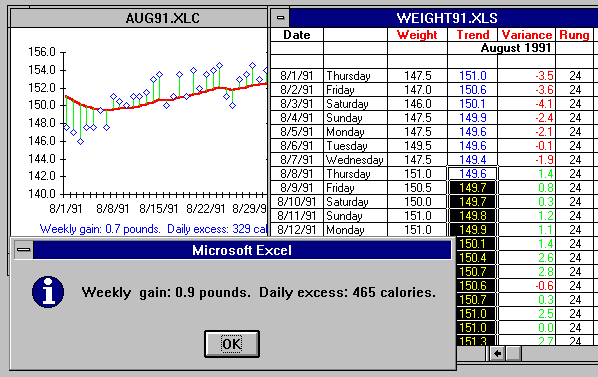Decide for yourself how closely you want to track the slope of the trend and balance your calories. You can view it as a kind of game, worth playing well in pursuit of a perfectly flat trend line. On the other hand, the whole idea of adding ten calories one month and subtracting fifteen the next may seem a particularly horrid example of obsessive compulsive behaviour. No matter, what's really important is what you do when the trend line wanders outside the 5 pound band centred around your weight goal. If your goal is 150 pounds, the band limits are 147.5 and 152.5. Whenever the trend line ends a month outside this range, action to correct the divergence is triggered. In the chart above, the rapid rise left the trend right at 152.5 at month's end. If the rise were not halted by reducing calories based on the slope of the trend, by next month the trend would have climbed well above 152.5, requiring a mandatory cutback to restore the trend to below that mark.
If the trend changes during a month, the calorie excess or
deficit reported in the chart may be misleading, as explained on page
![]() . When the trend reverses,
it's best to calculate the calorie adjustment based on the
start and end weights of the trend divided by the number of days the
trend continued. Instructions for manually calculating calorie
excess or deficit are given on page
. When the trend reverses,
it's best to calculate the calorie adjustment based on the
start and end weights of the trend divided by the number of days the
trend continued. Instructions for manually calculating calorie
excess or deficit are given on page ![]() .
Excel users can obtain the calorie balance from a partial month trend
by selecting the trend cells for the portion of the month containing
the trend (for the chart above, you'd select August 8th through August
31st), then picking WEIGHT TREND SNAPSHOT or pressing the
accelerator key CONTROL+t. A window like the following
will appear.
.
Excel users can obtain the calorie balance from a partial month trend
by selecting the trend cells for the portion of the month containing
the trend (for the chart above, you'd select August 8th through August
31st), then picking WEIGHT TREND SNAPSHOT or pressing the
accelerator key CONTROL+t. A window like the following
will appear.

By considering only the part of August when the trend was rising, we obtain a more accurate estimate of the rate of weight gain and calorie surplus. Instead of the 329 calories calculated from the entire month, during the last three weeks there was actually an excess of 465 calories per day, indicating the need for a more severe cutback in food. If you were calculating by hand, you'd subtract the trend value on August 8th, 149.6, from the trend at the end of the month, 152.5, divide by the number of days between those dates (31-8=23), then multiply by 3500 calories per pound, yielding:

This estimate is equivalent to that calculated by Excel for the purpose of planning a calorie cutback.
When the trend rises above the band, reduce your calorie intake by more than the excess reported by the trend chart or calculated from the most recent trend as explained above. Next month's chart will show a falling trend line which should soon return or already be within the 5 pound band. Once the trend line ends the month between 147.5 and 152.5, resume the usual minor adjustments to your food intake as described above, based on the slope of the trend.
The adjustment you make when the trend line wanders outside the band is up to you. After you have a year or so of experience controlling your weight, you can usually figure out the reason for the rise pretty easily (too many extra large buckets of popcorn at the movies, your discovery that Señor Picante's Macho Cheese tortilla chips are the perfect complement to your Saturday night poker game, etc.). Correction consists simply of cutting back on the food that's responsible for the extra calories, plus a little more to bring the trend down to within the band.
How you adjust your calorie intake isn't important. What is essential is that you do adjust it. Whenever you end any month outside the 5 pound band you must deliberately reduce calorie intake (if you're above) or increase calorie intake (if below), by more than the calorie excess or deficit reported in the last trend chart. Once you make the indicated adjustment to what you eat, the trend line will quickly return to the goal weight.
By John Walker